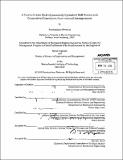A tool to create hydrodynamically optimized hull-forms with geometrical constraints from internal arrangements
Author(s)
Nestoras, Konstantinos, Nav.E. Massachusetts Institute of Technology
DownloadFull printable version (23.80Mb)
Other Contributors
Massachusetts Institute of Technology. Engineering Systems Division.
Advisor
Chryssostomos Chryssostomidis.
Terms of use
Metadata
Show full item recordAbstract
Internal arrangements and bulky equipment like machinery have been treated for many years as a secondary aspect of the ship design. Traditionally, in the design process, the centerpiece of the effort is the hull and its hydrodynamic performance. Once the hull of a ship has been selected, all the other systems, like propulsion and electric plants, are selected and fitted in the ship. Due to the fact that the hull is considered as the most important system of the ship, any compromises and systems trade-offs that need to be done in the design process are focused mainly on all the systems apart from the hull-form. This inherent prioritization in the traditional design process, might lead to the selection of suboptimal solutions for the other systems like the propulsion and electric plants, which in turns might lead to a global suboptimal solution for the whole ship design. Unfortunately, these decisions bound the designed ship for lifetime and, down the road, might lead to excess operational costs. The tool developed in this thesis treats the internal arrangements and the hull-form of the ship as two systems that need to be optimized together and not on a decoupled manner. Thus, the selection of the propulsion and electric plants or even large weapon systems like VLCs becomes as important as the hull during the design process. Propulsion and electric systems can be preselected in the early stage design, based on their efficiency and then a hull can be wrapped around them. The optimization of the hull can be done either with the use of the Holtrop method or a potential flow panel method, which provides higher fidelity. The designer has the ability to utilize this tool in order to easily conduct trade-off studies between the internal arrangements and the hull-form or save time from their integration and allocate it in other important problems of the design. This could aid the decision-making process in the early stage of the design, where information is scarce, decisions are crucial and uncertainty is high.
Description
Thesis (Nav. E.)--Massachusetts Institute of Technology, Dept. of Mechanical Engineering; and, (S.M.)--Massachusetts Institute of Technology, Engineering Systems Division, 2013. Cataloged from PDF version of thesis. Includes bibliographical references (p. 145-146).
Date issued
2013Department
Massachusetts Institute of Technology. Department of Mechanical Engineering; Massachusetts Institute of Technology. Engineering Systems DivisionPublisher
Massachusetts Institute of Technology
Keywords
Mechanical Engineering., Engineering Systems Division.